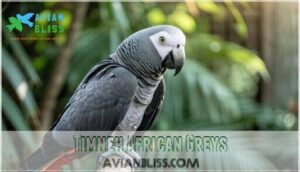This site is supported by our readers. We may earn a commission, at no cost to you, if you purchase through links.

These remarkable birds don’t just mimic sounds—they understand context, solve problems, and form deep emotional bonds with their human companions.
With their striking silver-gray plumage and bright red tail feathers, they’re as beautiful as they are brilliant.
African Grey Parrots require specialized care, including a nutrient-rich diet, mental stimulation, and consistent social interaction to thrive.
Their intelligence comes with sensitivity, making them both rewarding and challenging companions.
Understanding their unique needs transforms ownership from overwhelming to extraordinary.
Table Of Contents
- Key Takeaways
- African Grey Parrot Overview
- Types of African Greys
- African Grey Behavior
- Caring for African Greys
- African Grey Health
- Conservation Status
- African Grey Ownership
- Frequently Asked Questions (FAQs)
- How much does a African grey parrot cost?
- Is an African grey parrot a good pet?
- Are African Grey parrots legal in the US?
- Can African gray parrots talk?
- Are African grey parrots good pets?
- What are the cons of African grey parrots?
- What is the lifespan of an African grey parrot?
- How do African Greys interact with other pets?
- What is the cost of owning an African Grey?
- Can African Greys be left alone during vacations?
- Conclusion
Key Takeaways
- You’re committing to a 50-70 year relationship – African Grey parrots live as long as humans and require consistent daily interaction, making them lifelong companions rather than typical pets.
- They’re incredibly intelligent but emotionally sensitive – With the cognitive abilities of a 5-year-old child, they’ll solve problems and understand context, but they’re also prone to stress-related behaviors like feather-plucking when their complex needs aren’t met.
- You’ll need specialized care and significant investment – These birds require spacious housing, high-quality pelleted diets, mental stimulation, and exotic veterinary care, with lifetime costs exceeding $50,000.
- They’re endangered in the wild but legally owned when captive-bred – Wild populations have declined by over 50% due to illegal trade and habitat loss, so you must source from reputable breeders, not wild-caught birds.
African Grey Parrot Overview
You’ve encountered one of nature’s most remarkable companions, the African Grey parrot, whose intelligence rivals that of a 5-year-old child and whose lifelong bond with you can span decades.
These medium-sized parrots, scientifically known as Psittacus erithacus, combine striking grey plumage with bright red tail feathers and possess an extraordinary ability to understand and mimic human speech with remarkable clarity, which includes their ability to form a lifelong bond and exhibit intelligence that rivals that of a child, making them truly remarkable companions.
Physical Features
You’ll instantly recognize African Greys by their distinctive silver-grey plumage and striking red tail feathers.
These medium-sized parrots showcase remarkable physical features that make them unmistakable.
These distinctive birds stand out with their elegant grey feathers and brilliant red tails.
- Feather Colors: Mainly grey with darker wing feathers and brilliant red tail plumage
- Beak Shape: Strong black mandible perfectly designed for cracking nuts and seeds
- Eye Color: Bright yellow irises surrounded by white facial markings (juveniles have dark eyes)
Their physical features include a robust beak built for their specialized diet and head feathers with subtle white edges that create texture.
Intelligence Rate
Your African grey’s brain works like a 5-year-old child’s, showcasing remarkable cognitive ability and problem-solving skills.
These intelligent birds demonstrate exceptional memory capacity, mastering complex learning strategies through repetition and observation.
Their advanced brain development enables them to understand cause-and-effect relationships, recognize patterns, and adapt behaviors.
This avian intelligence makes African greys among the most psychologically complex parrots, capable of emotional responses and strategic thinking that rivals young children’s mental capabilities.
Species Classification
Beyond their remarkable intelligence, you’ll find African Grey parrots belong to a fascinating taxonomic puzzle that scientists have recently solved.
Modern genetic studies and morphological analysis have revolutionized our understanding of these remarkable bird species classification systems.
Here’s what current taxonomy systems reveal about African Grey parrot species identification:
- Scientific Classification: Psittacus erithacus represents the Congo African Grey, while Psittacus timneh now stands as a separate species (formerly considered a subspecies)
- Classification Methods: Advanced genetic studies combined with morphological analysis led to the 2012 taxonomic revision separating these parrot species
- Species Identification: No recognized parrot subspecies exist within Psittacus erithacus, simplifying identification for researchers and bird enthusiasts alike
- Modern Understanding: Recent classification methods have eliminated previous confusion, establishing clear boundaries between these distinct African Grey populations
This taxonomic clarity helps you better understand what makes your feathered companion unique within the parrot family tree.
Types of African Greys
You’ll encounter two distinct subspecies of African Grey parrots, each with unique characteristics that make identification straightforward.
The Congo African Grey is larger and more common, while the Timneh African Grey is smaller with distinctive coloring differences.
Congo African Greys
Congo African Greys represent the larger subspecies of African grey parrot, weighing 350-650 grams with 18-20 inch wingspans.
You’ll recognize them by their bright red tail feathers and distinctive grey feathers covering their robust bodies.
These Congo African Grey parrots thrive in dense Congo habitat areas across Central Africa.
Their African diet consists of fruits, seeds, and nuts found in their native forests, influencing proper grey parrot care requirements in captivity.
To guarantee proper care, making it vital to understand their diet and nutrition needs.
Timneh African Greys
Smaller than their Congo cousins, Timneh African Greys showcase distinct characteristics that make them equally enchanting parrot species.
These compact birds display darker grey feathers with a distinctive pink-horn colored beak, setting them apart from other African grey parrot varieties.
Their tail patterns range from dark red to brown, creating unique individual markings.
Timneh Size typically reaches 9-11 inches with remarkable social dynamics in both wild and captive settings.
Size and Weight Differences
When comparing parrot species, you’ll notice significant size differences between Congo African grey and Timneh African grey varieties.
Congo African greys measure 14-16 inches with substantial weight variance of 350-650 grams, while Timneh African greys are markedly smaller at 9-11 inches and 250-375 grams.
These body proportions affect wingspan, beak length, and overall feather density appearance.
Understanding the unique characteristics of exotic bird types is essential for classifying and caring for these birds.
African Grey Behavior
You’ll discover that African Grey parrots display remarkable intelligence comparable to a 5-year-old child, with problem-solving abilities that often surprise even experienced bird owners.
These highly social birds form deep emotional bonds with their human families and require consistent interaction to thrive in captivity.
High Intelligence
Your African grey’s brain works like a sophisticated computer, processing information with the cognitive ability of a 5-year-old child.
These remarkable birds demonstrate exceptional problem solving skills, from opening complex locks to using tools creatively.
Their impressive memory capacity allows them to remember hundreds of words and associate them with specific meanings.
African grey intelligence shines through their learning strategies – they’ll observe, practice, and perfect new behaviors systematically.
This intelligent behavior makes african grey parrots fascinating companions who constantly surprise owners with their mental capabilities.
Vocal Mimicry
Your grey parrot’s vocal mimicry abilities will astound you with their remarkable precision and range.
These intelligent birds demonstrate exceptional vocal learning capabilities that set them apart from other species.
Here’s what makes their mimicry skills extraordinary:
- Sound reproduction accuracy – They can mimic human speech with up to 90% fidelity
- Vocabulary capacity – Individual birds learn over 200 different words and environmental sounds
- Contextual usage – Many demonstrate true understanding, using words appropriately rather than just repeating
Their advanced speech patterns emerge through dedicated vocal learning, with some individuals maintaining learned sounds for years without reinforcement.
Strong Bonds
Once you welcome an African grey into your home, you’ll discover these birds don’t just live alongside you—they choose you as their flock.
Through consistent bonding techniques and daily trust building, your feathered companion develops profound emotional connections that mirror human relationships.
Their emotional sensitivity means they’ll read your moods, respond to your voice, and crave meaningful social interaction that fulfills their deep socialization needs.
Understanding territorial behavior is essential in creating a harmonious environment for your African grey parrot.
Playful Nature
Curiosity defines your African grey’s daily adventures as they explore every corner of their environment.
These intelligent birds crave mental stimulation through interactive parrot toys, puzzle feeders, and rotating enrichment activities.
They’ll investigate new objects with their beaks and feet, demonstrating remarkable problem-solving skills.
Without adequate parrot exercise and engaging play opportunities, they may develop destructive behavior like feather-plucking or excessive screaming.
Sensitive
When stress overwhelms your African grey, their emotional capacities become fragile as glass.
These birds possess remarkable emotional sensitivity that requires careful stress management and environmental awareness.
Sudden loud noises trigger noise sensitivity, while changes in routine can spark social anxiety.
Your parrot’s emotional needs include consistent mental stimulation and gradual parrot socialization.
Understanding bird emotional sensitivity helps prevent parrot stress from escalating into destructive behaviors like feather-plucking or excessive screaming, which can be triggered by poor management of their emotional needs, including lack of consistent mental stimulation and inadequate parrot socialization.
Caring for African Greys
Proper African Grey care requires meeting their complex physical, social, and psychological needs through structured daily routines.
You’ll need to provide spacious housing, balanced nutrition, consistent social interaction, and mental enrichment to maintain their health and prevent behavioral issues, ensuring you meet their complex needs.
Proper Housing
Your African grey needs a spacious cage measuring at least 36x48x48 inches with bar spacing between 3/4 to 1 inch.
Install proper ventilation systems and natural wood perches of varying diameters. Skip nesting boxes unless breeding—they can trigger hormonal behaviors.
Position the parrot habitat away from drafts but near family activity for social engagement.
When selecting a cage, consider the importance of large parrot cages to guarantee your bird has enough space to move around comfortably.
Diet and Nutrition
Your bird’s balanced diet starts with 60-70% high-quality pellets as the foundation.
Fresh fruits and vegetables should comprise 20-25% of their parrot diet, while seeds and nuts stay under 10%.
This pelleted diet approach meets essential nutrient needs better than seed-heavy alternatives.
To find the right mix, consider parrot food options online.
Establish a consistent feeding schedule with morning and evening meals, plus fresh water daily.
Food variety prevents vitamin deficiencies common in grey parrot diet plans.
Social Interaction
Your African grey craves social connection just like their wild counterparts who gather in massive flocks.
These intelligent birds need daily interaction to prevent loneliness and behavioral problems. Understanding parrot psychology helps you recognize their communication methods and bonding behaviors.
Here’s how to meet their social needs:
- Daily interaction sessions – Spend at least 2-3 hours talking, playing, or training together
- Family involvement – Include your grey in household activities so they feel part of the flock
- Consistent routines – Maintain regular schedules for meals, play, and bedtime to reduce stress
Strong bonds develop through consistent positive interactions, mimicking the juvenile learning patterns seen in wild flocks.
Mental Stimulation
Why settle for basic entertainment when your African grey’s brilliant mind craves complex challenges?
Puzzle toys and foraging opportunities mirror natural behaviors, while training techniques build trust and confidence.
Environmental enrichment through mentally stimulating toys prevents boredom and destructive habits.
Consider providing stimulating parrot toys to keep them occupied.
Understanding parrot psychology helps you rotate activities, keeping your feathered Einstein engaged and thriving, with mentally stimulating toys and natural behaviors.
African Grey Health
Your African Grey’s health depends on recognizing warning signs early and maintaining regular veterinary care.
These intelligent birds hide illness well, so you’ll need to watch for subtle changes in behavior, appetite, or appearance that signal potential health problems, which can be critical to identify early.
Signs of Illness
Your parrot’s health depends on recognizing early warning signs.
Watch for these red flags:
- Feather Plucking – Self-destructive behavior indicating stress or illness
- Appetite Changes – Sudden refusal to eat or dramatic dietary shifts
- Droppings Analysis – Color, consistency, or frequency changes signal internal issues
- Respiratory Distress – Labored breathing, tail bobbing, or wheezing sounds
Behavioral Shifts often precede physical symptoms in parrot health.
These parrot illness signs require immediate parrot veterinary checkups before conditions worsen.
Common Health Issues
Several health conditions plague African Grey parrots, making awareness essential for prevention.
Vitamin deficiencies affect up to 40% of captive birds, while feather plucking impacts 10-15% of greys.
Respiratory infections and psittacosis pose serious threats, alongside beak disease which can prove fatal.
| Health Issue | Prevalence | Risk Level |
|---|---|---|
| Vitamin A Deficiency | 30-40% | High |
| Feather Plucking | 10-15% | Moderate |
| Respiratory Infections | 20-25% | High |
Veterinary Care
Beyond routine checkups, you’ll need specialized exotic veterinarians experienced in avian diseases like psittacosis.
Preventative care includes annual exams, blood work, and discussing medication safety with your vet.
Emergency treatment becomes essential when health problems arise suddenly, and regular veterinary care helps catch issues early, ensuring your parrot’s long-term wellbeing through professional monitoring and treatment.
Conservation Status
If you’re concerned about these beautiful birds, you’re right to be worried about their future.
African grey parrots are now classified as endangered, facing serious threats from illegal pet trade, habitat destruction, and hunting that have reduced wild populations by over 50% in many areas.
Threats to Wild Populations
Wild African grey populations face catastrophic threats that have triggered their IUCN Red List classification.
Major dangers include:
- Habitat Loss – Deforestation has eliminated over 50% of suitable forest areas in three decades
- Illegal Trade – An estimated 100,000 parrots are captured annually for the pet market
- Hunting Impacts – Birds are targeted for food and traditional medicine in some regions
- Population Decline – Some areas report 90-99% declines since the early 1990s
These threats collectively contribute to the significant decline of Wild African grey populations, emphasizing the need for conservation efforts to protect these birds from extinction.
Conservation Efforts
Multiple organizations are working to save endangered African grey parrots through coordinated conservation efforts.
Habitat preservation protects vital rainforest nesting sites, while trade regulation under CITES bans international commercial sales.
Captive breeding programs maintain genetic diversity for future reintroduction.
Population monitoring tracks wild numbers, and local involvement engages communities in bird conservation initiatives, creating sustainable parrot conservation solutions.
Responsible Ownership
As a potential African grey owner, you’re entering a 50-70 year commitment that requires ethical sourcing from reputable breeders, not wild-caught birds.
Your parrot needs extensive daily enrichment and social interaction to prevent behavioral issues like feather-plucking.
Research local legal considerations and prepare for intensive parrot care demands.
Understanding a species’ conservation status explained is essential for responsible ownership.
African Grey Ownership
Owning an African grey parrot isn’t just getting a pet—you’re committing to a lifelong companion with the intelligence of a 5-year-old child.
These remarkable birds require extensive preparation, consistent care, and a genuine understanding of their complex needs spanning 50-70 years.
Pros and Cons of Ownership
African Grey ownership brings incredible rewards alongside significant challenges.
These companion parrots offer unmatched intelligence and emotional bonds, but demand high-maintenance care with substantial time demands and cost factors.
Their vocal abilities create strong connections, yet noise levels can strain relationships.
The commitment level spans decades, requiring consistent parrot care through life changes, and managing the emotional toll of their sensitive nature and complex needs, which can be a significant time demand and have substantial cost factors.
Preparing for Ownership
Before you bring home your feathered friend, you’ll need to tackle the basics that’ll set you both up for success. Initial Costs can reach $2,000-$4,000 including a proper Cage Size (minimum 36"x48"x48"), quality diet, and vet setup.
Consider your Time Commitment – these intelligent companions need 4-6 hours daily interaction.
- Family Compatibility: Assess household dynamics, children’s ages, and everyone’s comfort with Noise Levels (African greys can be loud)
- Parrot Proof your home by removing toxic plants, securing electrical cords, and eliminating potential hazards
- Research Parrot Adoption centers and reputable breeders who prioritize health testing and proper socialization
- Establish relationships with avian veterinarians experienced in Pet Parrots and Bird Ownership before bringing your new companion home
Long-term Commitment
You’re signing up for a 50-70 year parrot lifespan journey that’ll outlast many life chapters.
Generational Care planning becomes essential since your bird might need Estate Planning considerations.
Lifetime Costs exceed $50,000 over their lifespan, while Behavioral Challenges intensify with age.
Your Owners Lifestyle must accommodate decades of bird ownership responsibilities, making this commitment deeper than typical pet ownership, involving Estate Planning.
What to Expect as Owner
You’ll experience daily joys and challenges with your feathered companion.
Expect 2-3 hours of daily interaction, consistent parrot training sessions, and occasional behavioral challenges like screaming or feather-plucking.
One such challenge can be triggered by environmental and medical factors.
Your pet bird will test boundaries, demand attention, and create a significant financial burden through specialized diets, toys, and veterinary care.
Bird owners discover that parrot behavior requires patience, while bird care becomes a rewarding lifestyle.
Frequently Asked Questions (FAQs)
How much does a African grey parrot cost?
You’ll pay $800-$4,000 for the bird itself, depending on type, age, and gender.
Monthly maintenance costs run $115-$265 for food, veterinary care, and supplies.
This intelligent companion’s lifetime investment adds up quickly.
Potential owners should also consider one-time setup expenses such as a new cage for their companion.
Is an African grey parrot a good pet?
African grey parrots can make excellent pets for experienced bird owners.
They’re incredibly intelligent, living 50-70 years, but require extensive daily interaction, mental stimulation, and consistent care to prevent behavioral issues like feather-plucking.
Are African Grey parrots legal in the US?
Perfectly positioned pets are permissible, but purchasing prohibitions persist.
You can legally own captive-bred birds domestically, but international trade of individuals caught in the wild is banned under CITES regulations since
Can African gray parrots talk?
Yes, you’ll find that African grey parrots are exceptional talkers with remarkable vocal abilities.
They can learn hundreds of words, mimic human speech clearly, and demonstrate understanding of language concepts with problem-solving skills, which showcases their exceptional ability as vocal learners.
Are African grey parrots good pets?
They’re exceptional pets for experienced bird owners who can provide consistent socialization, mental stimulation, and decades of commitment. Their intelligence requires engaging activities and patient training to prevent behavioral issues.
What are the cons of African grey parrots?
These intelligent birds demand constant attention, live 50-70 years, require specialized diets, scream loudly, pluck feathers when stressed, need expensive veterinary care, and aren’t suitable for inexperienced owners.
What is the lifespan of an African grey parrot?
Your African grey parrot’s lifespan typically ranges from 50-70 years with proper care, making them lifelong companions.
They’ll outlive many pets and require consistent veterinary care, social interaction, and quality nutrition throughout their decades-long lives.
How do African Greys interact with other pets?
Studies show 80% of multi-pet households experience initial territorial challenges.
You’ll need careful introductions since African Greys can be territorial with cats and dogs.
They may bond selectively, requiring supervised interactions and separate spaces initially for everyone’s safety.
What is the cost of owning an African Grey?
You’ll spend $1,000-$3,000 initially for the bird, plus $200-$500 monthly for food, vet care, and supplies. Over their 50-70 year lifespan, total costs reach $15,000-$40,
Can African Greys be left alone during vacations?
No, you shouldn’t leave African Greys alone during vacations. These highly social, intelligent birds require daily interaction and can develop severe behavioral issues like feather-plucking when isolated for extended periods.
Conclusion
Like a trusted companion who’ll share your life for decades, owning an African Grey Parrot requires dedication, patience, and understanding.
These remarkable birds aren’t just pets—they’re intelligent family members who’ll challenge and reward you daily.
With proper care, nutrition, and mental stimulation, your African Grey Parrot will thrive and form an unbreakable bond that enriches both your lives.
Remember, you’re not just caring for a bird; you’re nurturing a lifelong friendship with one of nature’s most extraordinary creatures.














